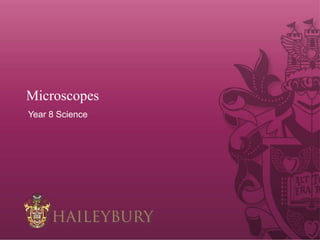
Microscope introduction
- 2. Seeing things differently Microscopes expanded our horizons in more ways than many of us realise. What do you take for granted today, that would not have been possible without the microscope?
- 3. What is a microscope? A microscope is an instrument that produces an enlarged image of an object. Biologists use microscopes to study things that are too small to be seen with the unaided eye
- 4. The light microscope Most microscopes are called light microscopes because they accomplish their task by using lenses to bend light rays.
- 5. Parts of a Microscope Eyepiece (Ocular): Usually contains a 10X lens. Arm: contains the housing for the fine and coarse adjustments and connects the base of the microscope to the nosepiece and ocular. Nosepiece: A rotating head that has the objective lenses attached to it. The lens to be used should "click" into position when the wheel is gently turned so that it is directly over the speciman slide. Objective: Basically a housing for a lens. Our microscopes have three objective lenses - 4X, 10X, and 40X. Stage: The specimen slides rests on this part of the microscope. Light source: Located directly under the stage.
- 6. Parts of a Microscope Coarse adjustment knobs: The larger of two sets of knobs located on either side of the arm, just above the base. This adjustment is used to make large adjustments in focusing by moving the lenses up and down. Never use this adjustment when using the 40X objective. Fine adjustment knobs: The smaller of two sets of knobs located on either side of the arm. This adjustment is used to make small adjustments in focusing. It has a limited amount of movement and is most efficiently used after focusing with the 4X objective and coarse focus, then increasing magnification and making final adjustments with the fine focus knob. Adjustable diaphragm: This rotating wheel on the underside of the stage allows the user to adjust the amount of light that passes through the specimen. As a general rule, the lowest intensity of light that allows you to resolve the structure of the object you are viewing should be used.
- 7. Now its your turn! Complete the provided sheet, labelling all the parts of the microscope. This sheet is also available in your eLocker.
- 8. Care and Handling A microscope is a delicate piece of equipment and should be treated with care. Use two hands when carrying the microscope. Place one hand around the arm of the microscope and the other under the base for support. Carry the microscope upright and close to the body. Place the microscope flat on the table, but not too near the edge where it might be knocked off. DO NOT slide the microscope back and forth on the lab table. If it becomes necessary to clean the lenses on the microscope, ask your teacher for a piece of lens paper. Other materials, such as paper towel, can scratch the surface of the lens.
- 9. Important! Magnification: the increase of an object's apparent size. Field of view: the area visible through the microscope lenses. Field of view decreases as magnificaiton increases. Resolution: the power to show details clearly. Resolution allows the viewer to see two objects that are very close together as two objects rather than as one. Compound microscopes use multiple lenses to produce an increase in magnification. If the eyepiece lens enlarges by a factor of 10 (10X) and the objective lens enlarges by a factor of 40 (40X), the total magnification is the product of the two - 400X. Resolution is controlled by the quality of the lenses being used - the better the lenses, the better the resolution.
- 10. How to draw what you see. • For drawings only, use pencil - you can erase and shade areas. • Begin by identifying the area viewed through the microscope with a circle. • Specimens should be drawn to scale. If the specimen takes up the whole viewing field, make sure your drawing shows this. • Drawings should be labeled with the specimen name and magnification. • Drawings should be large enough to view details and have significant details labeled. • All labels should be written on the outside of the circle.
- 11. Your turn again! Set up the microscopes. Use the pre-prepared slides to practice focusing. Pay close attention to resolution, magnification and the field of view. Draw three examples of what you see in your exercise books.
